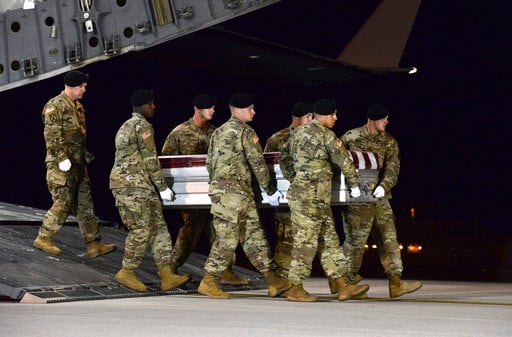WASHINGTON — Amid disturbing and sometimes conflicting reports of U.S. soldiers outnumbered and outgunned as they fought nearly 200 enemy fighters in Niger, the military is asking for patience as it tries to piece together what really happened on that deadly night.
Four U.S. soldiers were killed Oct. 4 when their patrol was ambushed near the village of Tongo Tongo, Niger. The soldiers and their Nigerien counterparts were on a mission to hunt down an ISIS commander, and several media reports, citing interviews with local villagers and Nigerien troops and officials, have painted a dire picture of the Americans battling a well-coordinated enemy force armed with trucks, motorbikes and heavy weapons.
“It is best to hold off until we have all the facts on hand,” Army Chief of Staff Gen. Mark Milley told reporters on Wednesday at the Pentagon.
“The family has a right to know everything first,” he added, when pressed for more details about the Niger ambush.
What happened the night of the ambush is still not entirely clear, and U.S. officials have provided few details. U.S. Africa Command has launched an investigation into the attack, with officials visiting the site of the ambush on Nov. 12. Officials have said the investigation will not be complete until at least January.
According to a report from The Guardian, U.S. soldiers killed in the attack were stripped of their boots, uniforms and weapons, and two of the American soldiers’ bodies were even dumped in the back of one of the enemy vehicles left behind after French jets scared the attackers away.
The soldiers fought for nearly six hours, and it was not until French Mirage jets arrived on the scene sometime later that the attackers fled the area.
The account from The Guardian calls into question the timeline of events presented by the Pentagon that French jets were overhead within two hours of the ambush.
Moreover, U.S. military officials have contended that there were no indications U.S. troops ever fell into enemy hands.
However, accounts by The Guardian claim U.S. troops were stripped of their clothes, and Sgt. La David Johnson’s body was found two days later, stripped and wedged between two trees with a severe wound to his head.
Kalla Moutari, Niger’s defense minister, has since denied Johnson was ever stripped of his clothes, according to The Guardian’s account.
Nevertheless, the Washington Post echoed some of those sentiments in a story published Nov. 10, that Johnson was not only found stripped of his clothes but with his arms tied behind his back and a giant wound to the back of his head, suggesting the U.S. soldier may have been captured and executed.
A U.S. official has pushed back on some of those claims.
“When the Americans received Johnson, his hands were not tied,” the U.S. official told the Washington Post.
The Washington Post story also contradicts some elements from The Guardian’s account. According to the Post, of the other three soldiers killed that day, one was found slumped in the team truck, and the other two were found on the ground with one clutching a walkie-talkie.
Some villagers told The Guardian that two of the U.S. soldiers’ bodies were found dumped in the back of an enemy pick-up truck, which was abandoned by the attackers when French jets were called on scene.
When pressed by reporters if he knew that U.S. soldiers in Niger were temporarily captured by the enemy, Milley replied, “I don’t know the answer with sufficient confidence to be able to say it.”
Shawn Snow is the senior reporter for Marine Corps Times and a Marine Corps veteran.
